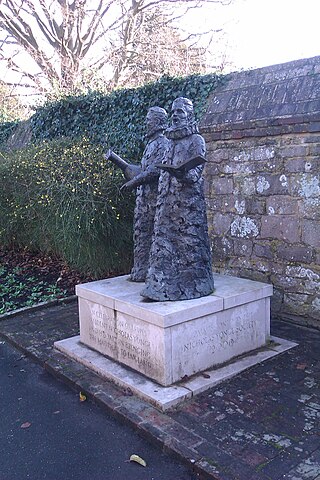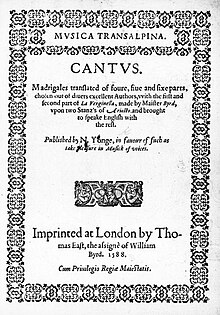
A madrigal is a form of secular vocal music most typical of the Renaissance and early Baroque (1600–1750) periods, although revisited by some later European composers. The polyphonic madrigal is unaccompanied, and the number of voices varies from two to eight, but usually features three to six voices, whilst the metre of the madrigal varies between two or three tercets, followed by one or two couplets. Unlike the verse-repeating strophic forms sung to the same music, most madrigals are through-composed, featuring different music for each stanza of lyrics, whereby the composer expresses the emotions contained in each line and in single words of the poem being sung.

Luca Marenzio was an Italian composer and singer of the late Renaissance.

Nicholas Yonge was an English singer and publisher. He is most famous for publishing the Musica transalpina (1588), a collection of Italian madrigals with their words translated into English. The first of the Elizabethan madrigal anthologies, it was enormously popular, and began a vogue for the composition and performance of madrigals in England which lasted into the first two decades of the 17th century. William Heather, founder of the music chair at Oxford University, included the book in his portrait, painted c. 1627, confirming the longevity of Musica transalpina's influence and popularity.
The English Madrigal School was the brief but intense flowering of the musical madrigal in England, mostly from 1588 to 1627, along with the composers who produced them. The English madrigals were a cappella, predominantly light in style, and generally began as either copies or direct translations of Italian models. Most were for three to six voices.
Alfonso Ferrabosco was an Italian composer. While mostly famous as the solitary Italian madrigalist working in England, and the one mainly responsible for the growth of the madrigal there, he also composed much sacred music. He also may have been a spy for Elizabeth I while he was in Italy.

The English Renaissance was a cultural and artistic movement in England from the early 16th century to the early 17th century. It is associated with the pan-European Renaissance that is usually regarded as beginning in Italy in the late 14th century. As in most of the rest of northern Europe, England saw little of these developments until more than a century later within the Northern Renaissance. Renaissance style and ideas were slow to penetrate England, and the Elizabethan era in the second half of the 16th century is usually regarded as the height of the English Renaissance. Many scholars see its beginnings in the early 16th century during the reign of Henry VIII.

Thomas Morley was an English composer, theorist, singer and organist of the Renaissance. He was one of the foremost members of the English Madrigal School. Referring to the strong Italian influence on the English madrigal, The New Grove Dictionary of Music and Musicians states that Morley was "chiefly responsible for grafting the Italian shoot on to the native stock and initiating the curiously brief but brilliant flowering of the madrigal that constitutes one of the most colourful episodes in the history of English music."
Thomas Tomkins was a Welsh-born composer of the late Tudor and early Stuart period. In addition to being one of the prominent members of the English Madrigal School, he was a skilled composer of keyboard and consort music, and the last member of the English virginalist school.
Giovanni de Macque was a Netherlandish composer of the late Renaissance and early Baroque, who spent almost his entire life in Italy. He was one of the most famous Neapolitan composers of the late 16th century; some of his experimentation with chromaticism was likely influenced by Carlo Gesualdo, who was an associate of his.
Alfonso Fontanelli was an Italian composer, writer, diplomat, courtier, and nobleman of the late Renaissance. He was one of the leading figures in the musically progressive Ferrara school in the late 16th century, and one of the earliest composers in the seconda pratica style at the transition to the Baroque era.
Thomas Watson (1555–1592) was an English poet and translator, and the pioneer of the English madrigal. His lyrics aside, he wrote largely in Latin, also being the first to translate Sophocles's Antigone from Greek. His incorporation of Italianate forms into English lyric verse influenced a generation of English writers, including Shakespeare, who was referred to in 1595 by William Covell as "Watson's heyre" (heir). He wrote both English and Latin compositions, and was particularly admired for the Latin. His unusual 18-line sonnets were influential, although the form was not generally taken up.

Cornelis Verdonck was a Flemish composer of the late Renaissance. He was one of the last members of the Franco-Flemish school of polyphony, and was a notable composer of madrigals in a style that blended both Italian and native Netherlandish idioms.
Thomas Lupo was an English composer and viol player of the late Elizabethan and Jacobean eras. Along with Orlando Gibbons, John Coprario, and Alfonso Ferrabosco, he was one of the principal developers of the repertory for viol consort.
Giovanni Ferretti was an Italian composer of the Renaissance, best known for his secular music. He was important in the development of the lighter kind of madrigal current in the 1570s related to the villanella, and was influential as far away as England.
Madrigal is the name of a form of poetry, the exact nature of which has never been decided in English.
Thomas East was an English printer who specialised in music. He has been described as a publisher, but that claim is debatable. He nevertheless made an important contribution to musical life in England. He printed the significant madrigal collection, Musica Transalpina, which appeared in 1588.

Drexel 4302, also known as the Sambrook Book based on an inscription from a former owner, Francis Sambrook, is a music manuscript containing vocal and keyboard music from Italian and British composers, documenting the transition from Renaissance to Baroque music. Though literature on the manuscript has assumed the copyist was Francis Tregian the Younger, recent analysis has demolished that hypothesis.
Il Trionfo Di Dori is a collection of 29 Italian madrigals published by Angelo Gardano in Venice in 1592. An edition and commentary was published by Edward Harrison Powley in 1974. In England the collection was imitated in The Triumphs of Oriana. In German the collection was edited as Musicalische Streitkrantzelein.

The First Book of Songs is a collection of songs by John Dowland which includes one instrumental piece. The book was published in London in 1597 and was reprinted four times during the composer's lifetime.








